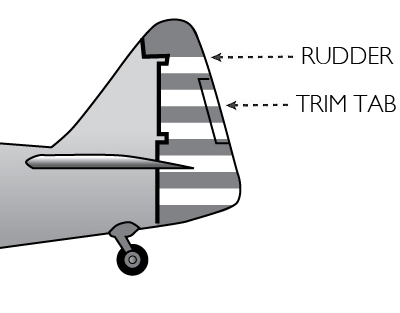YAW, It’s a Right-Left Thingy
We have discussed the weighty part of Tommy, and then the ups and downs. Now for a discussion on that part of the tail that sticks up on the rear of the Empennage. The fixed portion, or Vertical Stabilizer, and the moveable part, the Rudder.
We mentioned in Part Two, the length of the fuselage and location of the tail is a design feature. The size of the vertical stabilizer and rudder, and the horizontal stabilizer, are also designed the way they are for an important reason. Every propeller-driven aircraft has an issue of Torque, and a phenomenon called P-Factor.
According to the FAA, torque is defined as a “Force that produces a twisting or rotating motion.” While P-Factor is “The tendency for an aircraft to YAW to the left due to one blade of the propeller, the descending blade, as seen on the right from the cockpit, in a climb, producing more thrust than the ascending blade.” Therefore, the designers have made the vertical stabilizer and rudder the size they are to compensate for these forces.
 Captain Billy must overcome these tendencies in torque and P-factor by using the two rudder pedals located on the floor of the cockpit. These pedals are connected with cables that run from the pedals to the rudder. The right pedal will move the rudder to the right, and the left to the left. So, during acceleration and climbing, since the big radial engine and propeller want to pull Tommy to the left, he must compensate for this by applying pressure to the right rudder. If the designers had not placed the vertical stabilizer and rudder where they had, the pilot would not be able to keep his aircraft straight and therefore it would be uncontrollable.
Captain Billy must overcome these tendencies in torque and P-factor by using the two rudder pedals located on the floor of the cockpit. These pedals are connected with cables that run from the pedals to the rudder. The right pedal will move the rudder to the right, and the left to the left. So, during acceleration and climbing, since the big radial engine and propeller want to pull Tommy to the left, he must compensate for this by applying pressure to the right rudder. If the designers had not placed the vertical stabilizer and rudder where they had, the pilot would not be able to keep his aircraft straight and therefore it would be uncontrollable.
To assist in keeping Tommy flying straight and true, the rudder, like the elevator, has a Trim Tab located on the aft portion of the rudder to keep the aircraft flying straight through the air. It works in the opposite direction of the rudder to apply a force to keep the rudder where it needs to be.
The rudder is also used while turning. The correct amount of pressure and deflection must be used to keep Tommy in a Co-Ordinated Turn. The rudder is used in conjunction with the Ailerons. These will be discussed in the next part of this series.
Blue Skys and Tailwinds,
Captain Billy
If you have any questions, email Captain Billy!
